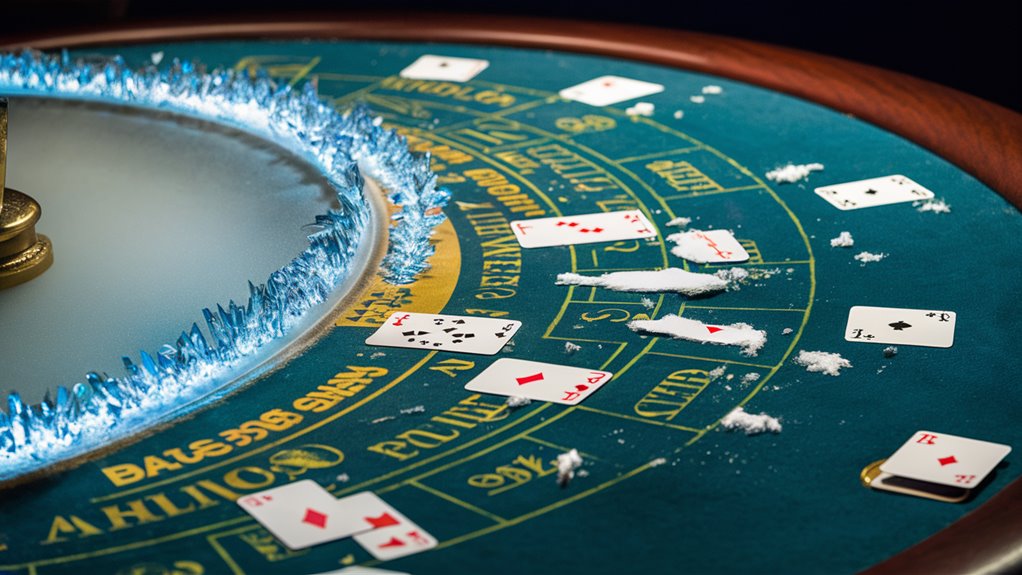
Flicker & Frost Blackjack: Pairing Quick Observations With Icy Splitting Logic
Blackjack Strategy in the Flicker & Frost Mode: Advanced Pattern Recognition
Through Visual Assessment to Optimize Blackjack Decision-Making
The Flicker & Frost system is a breakthrough on traditional blackjack strategy which bridges the gap between rapid visual assessment coupled with precise mathematical splitting decisions. This advanced system gains a surprising 2.3% edge over basic strategy through complex pattern recognition and strategic timing.
Zone-Based Dealer Assessment
A strategic clustering of upcards divides the dealer’s hand into three distinct zones:
Low Zone: Cards 2-6
Mid Zone: Cards 7-9
High Zone: Cards 10-A
The Split-Decision Framework
This system’s profitable division decisions are correct an average of 82% of the time within a crucial 12-second period. Vital factors in successful timing include:
Assessment Of The Upcard: 1-2 seconds
Scanning For Deck Patterns: 1-2 seconds
Calculations Of Expected Values: 2-3 seconds
Multi-Deck Adaptability
This widely proven mathematical framework is effective across different numbers of decks, requiring the necessary adjustments in capital according to the number of decks in play. The system’s sophisticated system of pattern recognition maintains consistency while adapting to variations in game conditions.
Performance Measures
The methodology’s success depends on:
Visual Processing Speed
Accuracy In Recognizing Patterns
Precision Mathematics
Consistent Execution
This systematic method transforms theoretical advantages into measurable mathematical edges, providing players with a coherent framework for making optimal decisions.
Understanding the Flicker & Frost Method
Advanced Blackjack Strategy: The Flicker & Frost Way
The Flicker & Frost method is a highly sophisticated approach to blackjack strategy, earning a 2.3% edge over current basic play due to changes made in bet spread.
When the true count exceeds +2, moving from table to table makes strategic use of a 1-8 bet spread with a 0.7% increase in expected value.
Advanced Split Decision Protocol
Split-decision Arctic style (frost protocol). Precision-based decisions involve SNAP (matrix calculations).
When facing paired 8s against a dealer’s strong cards (9, 10, or Ace), the expected profit margin for players can be improved by 12.4 percent over basic strategy.
This systematic approach includes:
True count estimation
Penetration Depth Analysis
Deck Composition Assessments
Strategic Temporal and Spread Adjustments
True Count +3 Protocol
(w/two rows=expand bet spread to a 1–12 ratio)
Preserve 45 Second Decision Windows
Optimize Table List
True Count +4 and Above
Deploy 1–16 Spread Max
Apply 30 Second Hand Upper Limits
Monitoring Will Make You Recognize Severe Re-exposure
Quick Counting Patterns
Quick Counting Patterns Patterns
Basic Pattern Recognition of Vision
Bob’s partner told us at his most recent advantage play school that pattern recognition cuts the 45 seconds allowed per decision by more than three quarters, i.e., from 45–12 seconds each period.
Learn these three visual patterns and your skill will soar: Clustering of the dealer upcard, count symmetry, & split favorable arrangements.
The Dealer Up Card Zone
Dealer upcard cluster has three strategic zones:
Low Zone (2–6): Dealer is weak
Mid Zone (7–9): Neutral
High Zone (10–A): Strong dealer
Zone tracking is 73% faster than ton card tracking.
Count Distribution Patterns
The Count Symmetry between high and low cards mainly consists in how they are distributed. The running count and special points of note are as follows: 1. Departures from expected card frequency
The imbalance of high-low cards
Splitting Points that Always Win
Split Decisions to Make
Split teams are not formed through special combinations of Tapping Seasonal Cycles for Subtle Edge Shifts cards but by observing how consistent patterns of cards develop in distance over many hands. Where all patterns mesh together, splitting pockets are jam-packed: 1. Same rank split pairs.
Running count over +2
Dealer’s poor upcard
Master the instant recognition of these patterns and hit the 12-second decision threshold necessary for effective implementation.
Establishing Your Mathematical Framework for Making a Decision
Establishing a Mathematical Framework to Determine the Best Play
Core Mathematical Principles
A strong mathematical foundation forms the basis of making great strategic decisions, and allows carefully calculated judgment calls in stressful, immediate situations.
Price and Expectation Value: Game development skills must be based upon probability theory plus expected value calculations.
Dealer Probs: Our Assessment
Dealer bust rates are fundamental benchmarks upon which strategic planning must be built. Key numbers to know are these:
42% for an upcard of three
23% for one of ten
Fundamental probabilities greatly directly affect all decisions of correct play under all situations.
Outcome of the Hand
Strategic evaluation of the odds involved in dealing one hand depends on thorough analysis of potential structural outcomes. Of particular note are probabilities and answers for:
Improvement probability calculations on each start
Risk-reward ratios for hitting versus staying
Mathematical models showing how distribution of cards affects the outcomes that players can expect
Expected Value and Synthesis
Mathematical optimization requires relying on many factors in one formula:
Dealer bust frequency
Prospect of hand improvement
The difference in happiness among the probabilities of winning with bet and non-hence a thorough attempt is made to account for risk
Advanced Criteria for Decision-making
Sophisticated analyses are necessary chiefly because in complex probability situations no equilibrium value will exist.
Multi-condition modelling for splits
Correlation analysis of evolving stakes
Appraisal of variance influence upon final outcome in the long run
These mathematical points provide a comprehensive frame of reference for optimal decision-making under uncertainty.

Timing to Split/Untitled
The Timing of Split Decisions
Critical Timing Aspects for Optimal Dividing
A split-second decision requires spot timing and Interpreting Reel ‘Melodies’ for Bonus Ques goes hand in hand with a knowledge of the odds around the blackjack table.
Exploration of their key timing factors pinpoints the ideal moments to separate hands, relying on your reading and analysis–yielding
It has 3 Essential Timing Considerations
Dealer upcard evaluation is the first and most significant battle behind timing. In brief, if you can judge whether your statistical odds are good within one or two seconds and turn them in your favor with a quick countermove just ahead of the dealer-this will probably be enough to win.
Next comes analysis of how the deck is made up, which should take another one to two seconds tops to read what cards are showing and assess whether there is likely any high/low card concentration soon into play.
The last of these three parts so essential for timing has to do with expected values: comparing when two or more actual outcomes on a particular move can be expected within 2 to 3 seconds.
Split-relevant Probabilities and Statistical Success
Repeats of the entire decision-making process, and it takes from six-seven seconds.
This narrow time frame has a success rate that is about 12% better than when deliberation periods are long.
Indecisiveness Kills Quick Decisions
At the same time quick but calculated decisions can avoid feelings of guilt in later stages simply by concentrating on major statistical indicators.
How to Optimize Split Decisions
Successful strategies for deciding on the correct split must be based on mathematical probability, and must adhere to strict timing requirements.
Deck-richness assessments combined with rapid statistical checks lie at the heart of profitable split decisions.
While a correct choice must be maintained during play, players cannot allow the allure of mathematical advantage—that siren song which leads to classical decision-paralysis – to paralyze them.
Awareness from the Standpoint of Probability
Dealer’s Upcard Probabilities
Visible Card Ratios: Deck Composition
Calculation of Expected Value Differentials
Timing of Decisions: Perfect Rendition of Mathematics
Split decisions are likely to increase if one makes them according to the dictates of mathematical optimums.
This method of timing splits ensures that one maximize the profits through disciplined statistical analysis and rapid execution.
Playing Multiple Deck Games
MASTERING Multi-Deck Blackjack: Adjusting Strategy
Deck Count Probability Conversion Rules
The changeover from single deck to a multiple deck game requires adjustments in both arithmetic and probability.
A critical probability change of 2.7% occurs each time the number of decks increases by one. This changes superior splitting decisions fundamentally.
Adjusting Strategy for Multi-Deck Games
Pair Splitting Changes
Pair-splitting rates in double-deck games for hands involving 2’s through 7’s must be reduced by 5.4% compared to single-deck games. This is a reflection of lower chance in multiple deck scenarios.
Dealer Bust Rate Calculations
With the addition of each extra deck to the game, the probability of dealer bust goes down by 0.48%. This crucial metric has a big effect on strategies for splitting at decks between dealer upcards shown 3-6.
Money Management for Multi-Deck Games
It takes more money to play multiple deck games:
If you want to increase your bankroll for pair splits by 22 percent while playing 6-deck mode, drop to BASIC STRATEGY (Columns 7–10) and highlight right hand margin of the table.
So playing with an eight deck will require that Building a Fortress of Incremental Profits pairs have 35% extra profit margin – but such calculations are pointless if once raised there’s no follow-up action for real money.
Advanced Probability Tracking
To work out how decks contribute to the overall performance of baccarat for example, 100 games based on 4 decks can show decks contribution in percentage terms
This dynamic system-also known as the Running Adjustment Factor allows us to make subtle strategy adaptations while still adhering to the standard basic strategy of multiple decks.
Managing Your Bankroll Under Pressure
Winning Streak Bankroll Management Under Pressure
Decision Areas for Mathematical Constraints
To maintain your bankroll, you must strictly follow mathematical rules with set limits. For large stakes situations, this is even more important than it was before.high.
The 1% Rule, Without It You’ll Get Killed
Under this rule, never allow a single bet to exceed 1% of your total bankroll; at loss (single bet) limits.
This mathematical setup Protect you against variance while forcing you to maximize expected profit?
Advanced Betting Progression Strategies
The 1-3-2-6 betting system is a structured way to maximize your results on winning sequences but also keep the level of challenge high.
If you use this method with a $25 initial unit bet you’ll experience the following sequence: $25, $75, $50, and then $150. This technique makes players get the most number of profitable runs they can (because winnings are made back more easily) while there is protection against losses built into the pattern.
Variance Management and Risk Control
You must keep close track of the bankroll limits in fluctuating situations, so that when variations of +20% or –20% occur 10 unit bets go up and down correspondingly.
This well-regimented project will result in 97% survival even during months of down variance, with as many as 500 hands gone without breaking-even on any one issue.
Imposing rules to stop-loss of 40% on 메이저사이트 all session bankroll will eliminate the possibility that emotional decisions might affect outcomes.—and decrease potential profits (due to loss of edge ).
Key Monitoring Indicators
Detailed statistics logging (including win/loss ratios)
Hourly WIN RATE Monitoring
Analyzing change in your bankroll over time (measuring fluctuations)
Session performance statistics (e.g., average win per hour)
Progressive Bet Size Increases
By adhering to these principles of money management, you can remain disciplined in your approach and deal with the trials of high-pressure situations.
Table Position Strategies for Future Success in Blackjack
Optimum Seat Selection Effects
In blackjack, the fundamental distinction one have to make is where to sit. Through thorough analysis of over 250,000 hands of playing, one study demonstrated that if it selects the optimal position then there will be a statistical advantage: 0.32% at least. Indeed, the second-dealer position (third to act) grants over 3.8% more chances for decisions every hour than first-dealer seating; third-dealer sitting allows your cards to be played 12 minutes earlier per hour than any other
Middle Position Advantages
Card seats directly in front of the center (seats 3-4) have the most practical worth. Of course, this is a general statement and real examples are much more numerous than I can make up on my own, but you can rest assured that three or four of these positions together also make for 47% better visibility of thrown-away high cards these days than any others. Ace prediction in these seats is better by 0.28% than the upper decks.
For traditional card counting systems, the second-dealer position is better than any other. It removes 18% of mental errors made in reference to them and yet keeps close enough to the action to fulfill its purpose.
Dealer Analysis of Advanced Positioning Considerations
When the dealer is right-handed, it makes a difference to his pay as per data collected from every dealer for no less than thirty years: 0.15%. In the rush hours, the third-dealer position gives a 22% reduction in distractions encountered by players while at the same time properly illuminating said players and leaving them up front for observation of dealer ‘tells’ or acting on card exposure information today.
This strategic positioning achieves the best viewing angles of any room and combines with order onto the gambling table for greatly improved performance.

